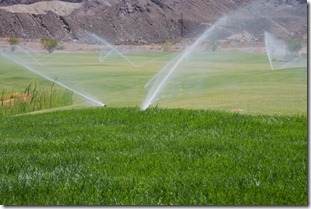Water and Chemicals Cast Long Shadows on U.S. Fairways
 A couple of years ago, on a visit to Scottsdale, Arizona, we went for a day hike to a state park east of the town. The main trail through the park climbed to an elevation of about a thousand feet above the land around it, which was entirely desert, except for a few sprawls of tract houses. But in the midst of all this dry country, what stood out the most were the intense, well-watered greens of a dozen golf courses .
A couple of years ago, on a visit to Scottsdale, Arizona, we went for a day hike to a state park east of the town. The main trail through the park climbed to an elevation of about a thousand feet above the land around it, which was entirely desert, except for a few sprawls of tract houses. But in the midst of all this dry country, what stood out the most were the intense, well-watered greens of a dozen golf courses .
Because south-central Arizona is a region with only nine inches of rainfall a year, water has always been a subject of contention, but golf links have nevertheless been able to obtain pretty much whatever they needed. In the entire Southwest, there appears to be no golf course that a desert water district didn’t like enough to refuse it the water it needed. Palm Springs, in the middle of a California desert, had 57 links in 2008, with a couple more on the way.
One estimate has the average American golf course using 312,000 gallons a day, but those in the desert are recorded as using, per day, a million gallons. That’s for a game that’s perceived as basically a rich man’s game, rich enough so that those who play consider themselves privileged. As aquifers shrink and drought seizes more and more of the southwest, the fact that one golf course can use as much water in a day as four American families of four use in a year is going to rankle. Fortunately for 2011, since heavy snows have given the Colorado River – a major source of Arizona water – an unusually high level of flow, the water use aspect of western golf courses will get a breather – for now. The only hopeful note is that a significant number of golf courses are beginning to use reclaimed water — a step in the right direction for the general welfare.
But it’s not only water that those grassy fairways and velvety greens use in enormous amounts. Maintaining that greenness in all but the depths of winter requires vast quantities of fertilizers, weed killers and pesticides.
The turf grasses used to create golf courses, like Kentucky Bluegrass and Bermuda grass, neither of which were native to the U.S. but are well-established here, normally have a growing season that lasts only a few months, after which they rest and turn brown. This can be prevented by repeated fertilization. Since brown is not an acceptable color for lawns and golf courses, the American lawn industry has a ready market for turf grass stimulants like the Scotts Company’s Turf Builder, for which five applications a year are recommended.
While the heavy use of fertilizers to keep turf green has a negative impact on local waters, where the excess nitrite, nitrate and ammonia inherent in fertilizers accumulates as runoff to create dead zones and algae blooms, the use of weed killers and pesticides has even more deleterious effects. The average golf course in the U.S. uses over 1000 pounds of pesticides annually, with some reporting usage up to 1500 pounds.
The story of turf pesticides is one long story of catch-up – after the damage is done. Once heavily sprayed with DDT until that was recognized as a toxic substance, lawns and golf courses were then subjected to large doses of Diazinon – until over a thousand geese landed on the fairways and greens of the Seawane Harbor Golf Club in Hempstead, N.Y. and died over the next few days. When the deaths and similar events around the country were finally attributed to Diazinon, one of the favored chemicals became 2,4-D (2,4-dichlorophenoxyacetic acid), an ingredient of Agent Orange – and is still in widespread use. Of course, pesticides and weed killers (which are also of doubtful chemical provenance) are also leached into our waterways as runoff.
There are enough American golf courses to cover the state of Delaware with green swards. How many more will be developed – or abandoned – in a declining economy is anybody’s guess.


